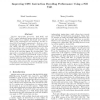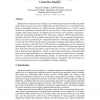271 search results - page 27 / 55 » Complexity-Effective Superscalar Processors |
ISLPED
2006
ACM
14 years 1 months ago
2006
ACM
Today’s superscalar microprocessors use large, heavily-ported physical register files (RFs) to increase the instruction throughput. The high complexity and power dissipation of ...
ISCA
2003
IEEE
14 years 25 days ago
2003
IEEE
Trends in microprocessors of increasing die size and clock speed and decreasing feature sizes have fueled rapidly increasing performance. However, the limited improvements in DRAM...
IEEEPACT
1999
IEEE
13 years 12 months ago
1999
IEEE
In current superscalar processors, all floating-point resources are idle during the execution of integer programs. As previous works show, this problem can be alleviated if the fl...
MICRO
1995
IEEE
13 years 11 months ago
1995
IEEE
Current superscalar processors, both RISC and CISC, require substantial instruction fetch and decode bandwidth to keep multiple functional units utilized. While CISC instructions ...
ARVLSI
1999
IEEE
13 years 12 months ago
1999
IEEE
Application-specific processor design is a promising approach for meeting the performance and cost goals of a system. Application-specific processors are especially promising for ...


